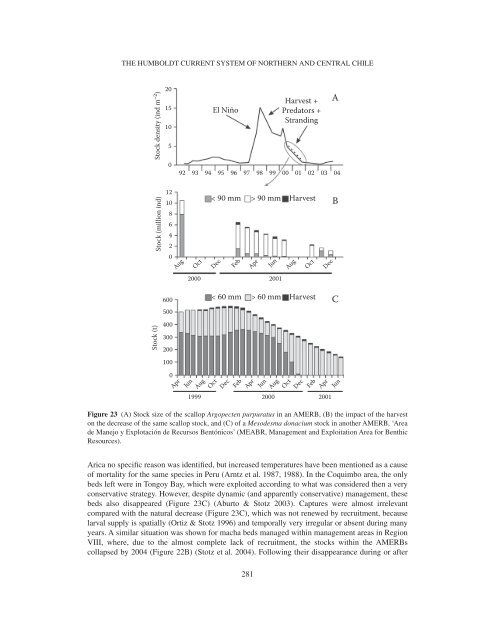MARTIN THIEL ET AL.& Fernández 1998, González et al. 2006), albeit it appears to be deficient in particular situations(e.g., Gelcich et al. 2006).Since resource stocks are continuously monitored in management areas, with captures wellcontrolled <strong>and</strong> registered, it has been possible to begin to underst<strong>and</strong> <strong>the</strong> underlying nature <strong>of</strong>fluctuating l<strong>and</strong>ings. Contrary to <strong>the</strong> above-described classical pattern <strong>of</strong> a badly managed fishery,it has <strong>of</strong>ten turned out to reflect <strong>the</strong> natural variability <strong>of</strong> <strong>the</strong> environment <strong>of</strong> <strong>the</strong> HCS. Global-scalephenomena, such as EN events, which produce an outburst <strong>of</strong> some resources <strong>and</strong> disappearance<strong>of</strong> o<strong>the</strong>rs, toge<strong>the</strong>r with more localised processes <strong>of</strong> upwelling <strong>and</strong> <strong>current</strong> <strong>system</strong>s, generate acomplex, spatially <strong>and</strong> temporally changing, mosaic <strong>of</strong> conditions. Fluctuating fisheries are mainly<strong>the</strong> consequence <strong>of</strong> this, <strong>the</strong> fishermen following (<strong>and</strong> suffering) natural variations, but not alwayscausing <strong>the</strong>m, as generally assumed. The following description <strong>of</strong> <strong>the</strong> four most valuable resourcesfished by artisanal fishermen illustrate this.Scallop fisheryCase studiesThe scallop fishery can be considered as a ‘boom-<strong>and</strong>-bust’ fishery, where <strong>the</strong> ‘boom’ is causedmainly by EN events (Wolff 1987, Stotz 2000, Wolff & Mendo 2000, Stotz & Mendo 2001, vonBr<strong>and</strong> et al. 2006). During EN, recruitment <strong>of</strong> Argopecten purpuratus is intense, <strong>and</strong> duringfollowing years, given <strong>the</strong> normal fast growth <strong>of</strong> <strong>the</strong> species (Stotz & González 1997), huge stocks<strong>of</strong> scallops build up, with fluctuations <strong>of</strong> several orders <strong>of</strong> magnitude between years (Figure 22A,stock increased with EN 1982–1983; Figure 23A stock increased with EN 1997–1998) (Stotz &Mendo 2001). However, following <strong>the</strong> increased scallop stocks, <strong>the</strong> development <strong>of</strong> similar predatorpopulations <strong>and</strong>/or <strong>the</strong> shift <strong>of</strong> prey preference <strong>of</strong> predators in response to increased scallopabundance (Ortiz et al. 2003), toge<strong>the</strong>r with <strong>the</strong> fishery, leads to an increasing mortality, whichfinally generates <strong>the</strong> ‘bust’ (Figure 23A) (Wolff 1987, Jesse & Stotz 2002, León & Stotz 2004).Fishermen are just able to take advantage <strong>of</strong> part <strong>of</strong> <strong>the</strong> EN production before <strong>the</strong> natural mortality,caused mainly by predation (e.g., by Octopus mimus), but also by mass str<strong>and</strong>ings (González et al.2001), takes most <strong>of</strong> <strong>the</strong> scallops away (Figure 23B). Normal (LN) years are characterised by small<strong>and</strong>, due to spatially (Aguilar & Stotz 2000) <strong>and</strong> temporally variable recruitment, fluctuating scallopstocks, which supply a low-level fishery (Figure 22A). Taking advantage mainly <strong>of</strong> natural recruitmentwhile preventing predation, in nor<strong>the</strong>rn Chile aquaculture has been able to build up stocks<strong>and</strong> harvest at levels several times above fishery production (Figure 22A) (Stotz 2000).Surf clam fisheryThe ‘macha’ Mesodesma donacium fishery also shows boom <strong>and</strong> bust fisheries along <strong>the</strong> coast(Figure 22B). In <strong>the</strong> past, on most sites a relatively stable low-level fishery existed, produced byfishermen working in <strong>the</strong> intertidal zone. During <strong>the</strong> mid-1970s fishermen learned also to dive forthis resource, which means putting <strong>the</strong> boat behind <strong>the</strong> breakers (‘rompiente’), diving, loaded withat least 40–50 kg <strong>of</strong> lead, through <strong>the</strong> surge <strong>and</strong> <strong>the</strong>n working underneath <strong>the</strong> breakers. This beganin Region V (32–35°S). After having depleted <strong>the</strong> local stocks in Region V, some fishermen cameover to Region IV (29–32°S), where <strong>the</strong> local fishermen quickly learned <strong>the</strong> same technique. Thishas generated a tradition <strong>of</strong> divers, mainly from Regions IV <strong>and</strong> V, working on <strong>the</strong> macha along<strong>the</strong> entire Chilean coast, making use <strong>of</strong> <strong>and</strong> depleting macha stocks throughout <strong>the</strong> country (Figure22A). However, after <strong>the</strong> establishment <strong>of</strong> AMERBs for this resource, o<strong>the</strong>r reasons for <strong>the</strong> depletionbecame apparent. With <strong>the</strong> EN 1997–1998 all <strong>the</strong> macha beds between Arica <strong>and</strong> Coquimbo,managed conservatively within AMERBs, died <strong>of</strong>f within a few days. The beds in Coquimbo weresmo<strong>the</strong>red by mud, washed into <strong>the</strong> bay by a river flood due to heavy rainfall (Mir<strong>and</strong>a 2001). For280
THE HUMBOLDT CURRENT SYSTEM OF NORTHERN AND CENTRAL CHILEStock density (ind m −2 )20151050El Niño92 93 94 95 96Harvest +Predators +Str<strong>and</strong>ingA97 98 99 00 01 02 03 04Stock (million ind)121086420AugOct< 90 mmDecFeb> 90 mm HarvestAprJunAugOctDecB20002001Stock (t)6005004003002001000AprJun< 60 mm > 60 mm HarvestAugOctDecFebFigure 23 (A) Stock size <strong>of</strong> <strong>the</strong> scallop Argopecten purpuratus in an AMERB, (B) <strong>the</strong> impact <strong>of</strong> <strong>the</strong> harveston <strong>the</strong> decrease <strong>of</strong> <strong>the</strong> same scallop stock, <strong>and</strong> (C) <strong>of</strong> a Mesodesma donacium stock in ano<strong>the</strong>r AMERB, ‘Areade Manejo y Explotación de Recursos Bentónicos’ (MEABR, Management <strong>and</strong> Exploitation Area for BenthicResources).AprJunAugOctDecFebApr1999 2000 2001CJunArica no specific reason was identified, but increased temperatures have been mentioned as a cause<strong>of</strong> mortality for <strong>the</strong> same species in Peru (Arntz et al. 1987, 1988). In <strong>the</strong> Coquimbo area, <strong>the</strong> onlybeds left were in Tongoy Bay, which were exploited according to what was considered <strong>the</strong>n a veryconservative strategy. However, despite dynamic (<strong>and</strong> apparently conservative) management, <strong>the</strong>sebeds also disappeared (Figure 23C) (Aburto & Stotz 2003). Captures were almost irrelevantcompared with <strong>the</strong> natural decrease (Figure 23C), which was not renewed by recruitment, becauselarval supply is spatially (Ortiz & Stotz 1996) <strong>and</strong> temporally very irregular or absent during manyyears. A similar situation was shown for macha beds managed within management areas in RegionVIII, where, due to <strong>the</strong> almost complete lack <strong>of</strong> recruitment, <strong>the</strong> stocks within <strong>the</strong> AMERBscollapsed by 2004 (Figure 22B) (Stotz et al. 2004). Following <strong>the</strong>ir disappearance during or after281










